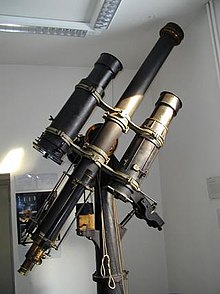Astrograph


Astrographs (also known as astrographs ) are special cameras that are used for scientific astrophotography . Despite long focal lengths, you have the ability to capture large fields in the sky and image them with high brightness.
For this task, your lenses should provide a particularly large (e.g. 300 mm × 300 mm) image field that is as flat as possible and free of distortion . The image scale should also remain constant over a large spectral range and should not change too much when it cools down at night . Already at the turn of the century before last, lens lenses were used to construct optics with a 40 cm aperture (see picture of the Bruce double astrograph).
Double astrographs
Double astrographs in particular were a useful tool in practical astronomy . They were produced until the second half of the 20th century . Two cameras of the same type are precisely tracked to the stars by an equatorial mount . By equipping the two astrographs differently with color filters or with a prism in front of one of the two lenses, comparative images of the same area of the sky, but with different information, can be made at the same time.
In this way you get photos of the same astronomical observation objects that differ only in color or a normal photo and one in which the stars have been pulled apart to form spectra . It is also conceivable to move one of the photo plates relative to the entire instrument. With this method you get a normal photo of a certain area of the sky, on which a comet or planetoid is shown as a line trace and a second, on which these objects are shown sharply and the stars as lines. Since the beginning of astrophotography, the second plates have also been used for confirmation, so as not to misinterpret plate errors or light reflections as newly discovered celestial bodies.
Optical construction
At the beginning of the 20th century , lenses for astrographers were used that were similar in structure to the photo lenses of that time . At that time these were three-lens symmetrically constructed lenses. A biconcave lens was located between two biconvex lenses . For photography , this system was further developed into the well-known Tessar by changing the rear lens into a cemented element made of two different glasses . The August Sonnefeld optics computer took a different approach in 1932 for large astrograph lenses. He split the front lens into two identical biconvex lenses and thus obtained an almost ideal optical system, the astro four-lens system.
Today in astrophotography Schmidt cameras and Ritchey-Chrétien-Cassegrain telescopes , which also have a very large field of view, are used for the same tasks . Lens telescopes are less used in scientific astronomy today. The principle of the binoculars is also obsolete or is used for completely different purposes ( interferometry ).
See also
- Astrometry , image measurement , satellite photogrammetry
- photographic star atlas , AGK3
- Johann Palisa , Max Wolf , Hans Vehrenberg
- Satellite camera , meteor station
- Comet seeker
literature
- August Sonnefeld : The importance of the four-lens for astro-optics. In: Zeiss News. Vol. 1, No. 2, 1932, ZDB -ID 163574-8 , pp. 15-20.